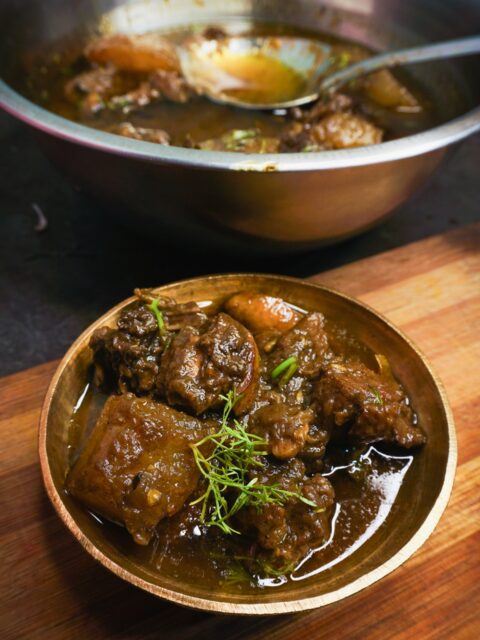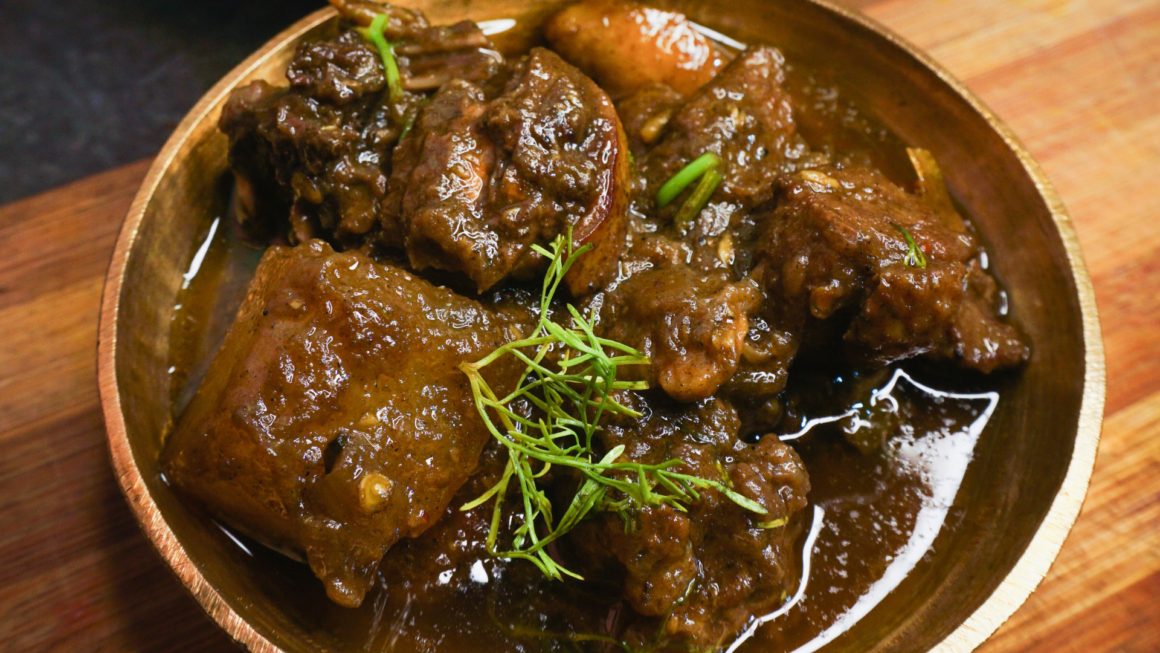Each state has its own distinct cooking style and unique qualities. Assamese cuisine, while rich, is somewhat lesser-known compared to culinary styles from other parts of the country. Thanks to Assam’s favourable climate and geographical position, the state boasts a wealth of flora and fauna, all of which contribute to its diverse cuisine. As the seasons change, we enjoy a variety of leafy and non-leafy vegetables, alongside meat and fish.
Depending on the occasion or festival, different dishes are prepared. For example, during Bihu, we make a variety of pithas (snacks) and ladoos. For other gatherings or feasts like Na-khua, Uruka, Bhogali Bihu, an array of main-course dishes are prepared.
One such beloved delicacy is “Kumurare Hahor Mangkho“. In Assamese, ‘Kumura‘ means ash-gourd and ‘Hahor Mangkho‘ means duck meat. Bhogali Bihu, Uruka & Na-khua are feasts associated with harvest celebrations. These special celebrations see families and friends coming together, cooking mouthwatering meals around a bonfire, with duck meat being an essential part of the menu. This robust meat, packed with flavour, is not only high in protein but also in healthy fats.
The richness of the duck is balanced by the addition of matured ash-gourd, which enhances this dish and adds a layer of complexity to the flavours, by lending a unique texture and slight sweetness.
This rustic dish holds a special place in the hearts of Assamese people, being a symbol of their cultural heritage and communal gatherings. Today, I am delighted to share this recipe with you in its simplest form – steeped in tradition and beloved by all, yet with a few unique nuances that make it truly special.

Kumurare Hahor Mangkho
Ingredients
- Duck meat – 500gm
- Ash gourd – 5-6 pieces
- Mustard Oil – 2 tbsp
- Bay leaves – 2
- Dried Chili – 1
- Large Onions, chopped – 2
- Ginger-Garlic paste – 2 tsp
- Green chilies, slit or chopped – 4-5
- Salt to taste
- Turmeric powder – ½ tsp
- Cumin (Jeera) powder – 1 tsp
- Garam masala – ½ tsp
- Freshly chopped coriander leaves for garnishing
- Water – 500-700ml
Method:
- Begin by washing and cleaning the duck meat and ash gourd, then set them aside.
- Heat the mustard oil in a kadhai (or deep frying pan).
- Add the bay leaves and dried chili.
- Introduce the chopped onion and green chilies to the kadhai, sautéing for about 2 minutes.
- Incorporate the ginger-garlic paste and sauté for a bit longer.
- Now it’s time to add the duck meat to the mix. Season with salt and turmeric powder, stirring well. Cover with a lid and allow it to cook on medium heat for a while, stirring occasionally.
- While stirring, add the cumin powder and mix it in well.
- Now, add the ash gourd to the mixture, combining it thoroughly before covering to cook again.
- Pour in warm water and bring the mixture to a boil.
- When the water has reduced by half, stir in the garam masala powder.
- Continue to cook the mixture until both the meat and ash gourd have softened.
- Remove the kadhai from the heat, garnish with fresh coriander leaves, and voilà, your dish is ready.
Serve this duck meat dish with steamed rice or topola bhaat (a sticky rice parcel) for an authentic experience. Alternatively, you can also enjoy it with chapati or roti.
Watch this recipe here – Kumurare Hahor Mangkho

Progoti Das hails from Bongaigaon, an industrial city in Assam. Despite her demanding role as a quality control analyst at the Bongaigaon refinery, where she works from 8 to 5, her passion for culinary arts never wanes. The kitchen transforms into her personal laboratory after office hours, where she enthusiastically experiments with spices and ingredients.
Her mother and grandmother, both exceptional cooks, have been her culinary mentors since childhood. Assam’s rich diversity, with its numerous communities and tribes, each boasting its unique food habits and recipes, continuously fuels her culinary exploration.
Progoti often finds inspiration in unexpected places, sometimes even from a humble vegetable vendor on the street. She firmly believes that food and recipes have their own narratives; they speak volumes about people and life. Thus, studying and researching these culinary stories for her is akin to understanding people and life more profoundly.
Translations and detailed descriptions are provided to give a better understanding of the story to people from different cultural backgrounds across the globe.

